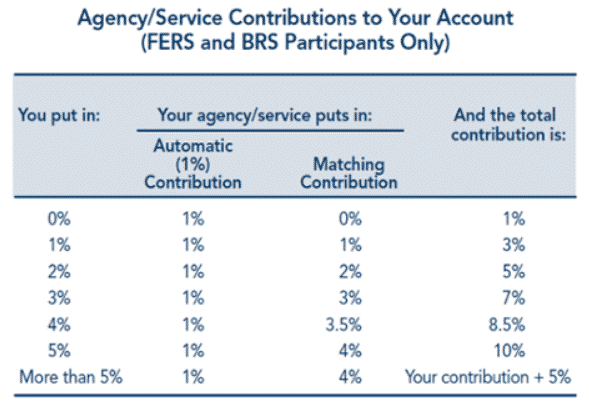TSP contribution limits 2022
TSP contribution limit for 2022 is 20,500 per person. Additionally, all federal employees over the age of 50 can contribute a catch-up of $6,500 per year.
What is TSP?
Thrift Saving Plan is a Federal retirement plan where both federal employees and agencies can make retirement contributions. Moreover, this retirement plan is one of the easiest and most effective ways for you to save for retirement. As a federal employee, you can make automatic contributions to your TSP directly through your employer’s payroll. You can choose the percentage of your salary that will go towards your retirement savings. TSP provides you with multiple investment options in stocks, fixed income, and lifecycle funds. Additionally, most agencies offer a TSP match up to a certain percentage. In most cases, you need to participate in the plan in order to get the match. For more information about investment options in your TSP account, check my article – “Grow your retirement savings with the Thrift Savings Plan.”
Who is Eligible to Participate in the TSP?
Most employees of the United States Government are eligible to participate in the Thrift Savings Plan. You are eligible if you are:
- Federal Employees’ Retirement System (FERS) employees (started on or after January 1, 1984)
- Civil Service Retirement System (CSRS) employees (started before January 1, 1984, and did not convert to FERS)
- Members of the uniformed services (active duty or Ready Reserve)
- Civilians in certain other categories of Government service
How much can I contribute to my TSP in 2022?
TSP contribution limits for 2022 increased slightly from 2021. IRS typically increases the maximum annual limit with the cost of living adjustment and inflation. These contribution limits apply to all employees who participate in the federal government’s Thrift Savings Plan, 401(k), 403(b), and 457 plans. Additionally, the limits apply to both tax-deferred and Roth contributions combined.
- Employees can contribute up to $19,500 to their TSP plan for 2022, a $1,000 increase from 2021.
- Employees of age 50 or over are eligible for an additional catch-up contribution of $6,500 in 2022, the same amount as 2021.
- Employee compensation limit for calculating TSP contributions is $305,000, $15,000 more than 2021
- For participants who contribute to both a civilian and a uniformed services TSP account during the year, the elective deferral and catch-up contribution limits apply to the combined amounts of traditional (tax-deferred) and Roth contributions in both accounts.
- Members of the uniformed services, receiving tax-exempt pay (i.e., pay that is subject to the combat zone tax exclusion), your contributions from that pay will also be tax-exempt. Your total contributions from all types of pay must not exceed the combined limit of $61,000 per year.
There are two types of contributions – tax-deferred traditional TSP and tax-exempt Roth TSP contributions.
Tax-deferred TSP
Most federal employees, typically, choose to make tax-deferred TSP contributions. These contributions are tax-deductible. They will lower your tax bill for the current tax year. Your investments will grow on a tax-deferred basis. Therefore, you will only owe federal and state taxes when you start withdrawing your savings.
Roth TSP
Roth TSP contributions are pretax. It means that you will pay all federal and state taxes before making your contributions. The advantage of Roth TSP is that your retirement savings will grow tax-free. As long as you keep your money until retirement, you will withdraw your gain tax-free. It’s a great alternative for young professionals and workers in a low tax bracket.
TSP Matching
Federal agencies can make a matching contribution up to the combined limit of $61,000 or $67,500 with the catch-up contribution. If you contribute the maximum allowed amount, your agency match cannot exceed $40,500 in 2022.
If you are an eligible FERS or BRS employee, you will receive matching contributions from your agency based on your regular employee contributions. Unlike most private companies, matching contributions are not subject to vesting requirements.
FERS or BRS participants receive matching contributions on the first 5% of your salary that you contribute each pay period. The first 3% of your contribution will receive a dollar-for-dollar match. The next 2% will be matched at 50 cents on the dollar. Contributions above 5% of your salary will not be matched.
Consider contributing at least 5% of your base salary to your TSP account so that you can receive the full amount of matching contributions.
Matching schedule

Opening your TSP account
FERS Employees
If you are a federal employee hired after July 31, 2010, your agency has automatically enrolled you in the TSP. By default, 3% of your base salary will be deducted from your paycheck each pay period and deposited in the traditional balance of your TSP account. If you decide, you have to make an election to change or stop your contributions.
If you are a FERS employee who started before August 1, 2010, you already have a TSP account with accruing 1% automatic contributions. In addition, you can make contributions to your account from your pay and receive additional matching contributions.
CSRS Employees
If you are a Federal civilian employee who started before January 1, 1984, your agency will establish your TSP account after you make a contribution election using your agency’s election system.
BRS Members of the Uniformed Services
Members of the uniformed services who began serving on or after January 1, 2018, will automatically enroll in the TSP once you serve 60 days. By default, 3% of your basic pay is deducted from your paycheck each pay period and deposited in the traditional balance of your TSP account. You have can always select to change or stop your contributions.
Contact Us

